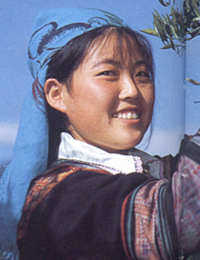


The Lahu ethnic minority has a population of 411,476 (by 1990), primarily distributed in Yunnan's Lancang Lahu Autonomous County and neighboring counties such as Menglian, Shuangjiang, and Simao. This region is also home to the Hans, Dais, Yis, Hanis, Blangs, and Was.
The Lahu language belongs to the Yi branch of the Tibeto-Burman Austronesian of the Chinese -Tibetan Phylum. Until an alphabetical script of the Lahu language was created in 1957, it had no written form. Previous to that, messages were frequently passed by woodcarving using the alphabet developed by Western priests. As a result of frequent contact with the Han and Dai people, most of the Lahus can also speak Chinese and the language of the Dais.
The Lahu trace their ancestry back to the ancient Qiang people, who immigrated to present day northern Yunnan from northwestern China early in the third century. Beginning in the 8th century, the emergence of the Nanzhao Kingdom forced the Lahu to move further southward. After the 10th century, they continued this southward migration on a larger scale. By the end of the 18th century, the Lahu had already inhabited in the areas in southern Yunnan they live in today.
This ethnic ethnic group has named themselves the Lahu, due to their long history of hunting tigers. "La" means the tiger, and "hu" means the method of roasting and eating. In their language, Lahu means "roasting tiger-meat on a fire".
The Lahu people used to worship many gods, and the deities of earth and revenge. Since Mahayana Buddhism was introduced into China early in the Qing period (1644-1911), some Lahus have been converted to it. There are also a small number of Lahus living in Lincang and Lancang counties who practice Christianity.
The Lahus have a rich stock of folk literature, most of which is related to physical labor. The most popular form of poetry is called "Tuopuke" or puzzle. The music and dances of the Lahu people have their unique styles and are permeated with life. There are many melodies and songs. Traditional musical instruments include the Lusheng (a reed pipe wind instrument) and three-stringed guitar. Their dances are characterized by foot tapping and swinging to the left.
The main festivals of the Lahu people include the Lahukuo Festival, the Torch Festival, the New Rice Festival, and the Duane Festival, etc. The Lahukuo Festival is the New Year Festival of the Lahu people. It is divided into large year (Women's Festival) and small year (Men's Festival) and is the most ceremonious and important festival of the Lahu people. The Women's Festival spans four days, from the first to the fourth day of the lunar New Year and the Men's Festival lasts three days, beginning in the ninth day of the lunar New Year.
Copyright ?2014 City of Pu'er, Yunnan Province, China. All rights Reserveed.
Contact: Tel: 86-0879-2189875 Email:puernews@126.com